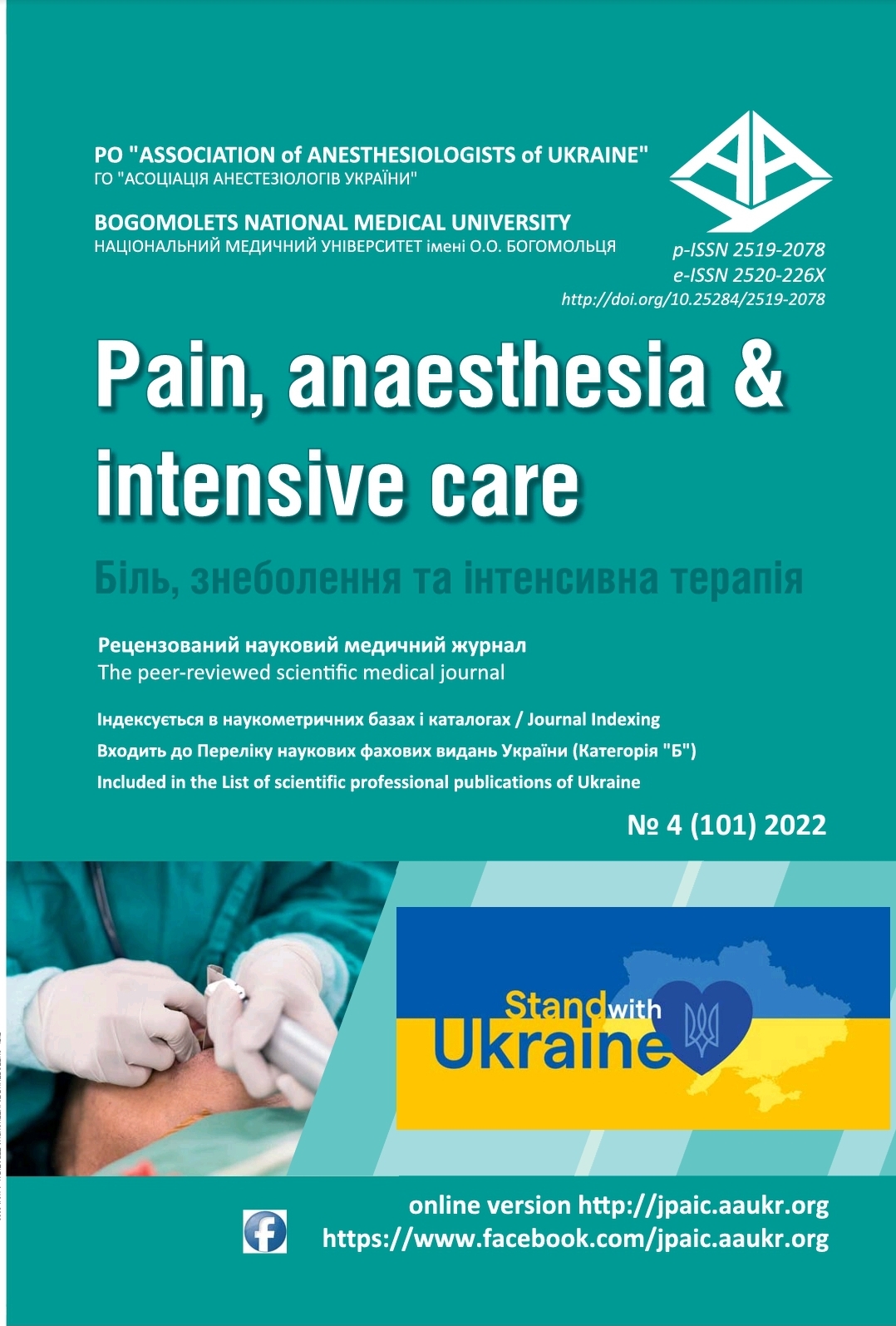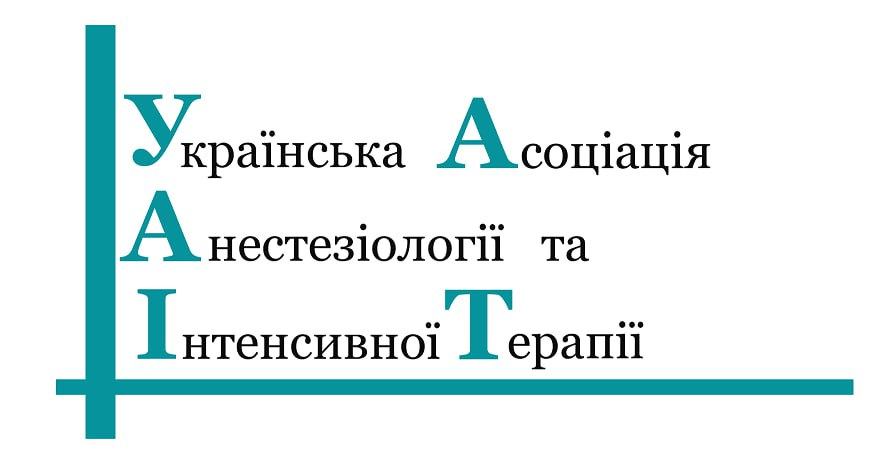ФАРМАКОКІНЕТИКА І ФАРМАКОДИНАМІКА ПРОПОФОЛУ ТА ДЕКСМЕДЕТОМІДИНУ ПРИ ПРОВЕДЕННІ ПЛАНОВИХ ПРОЦЕДУРНИХ СЕДАЦІЙ І ОСОБЛИВОСТІ ЇХ КОМБІНАЦІЇ (ОГЛЯД ЛІТЕРАТУРИ)
DOI:
https://doi.org/10.25284/2519-2078.4(101).2022.275116Ключові слова:
процедурна седація, пропофол, дексмедетомідин, фармакокінетика, фармакодинаміка, індукція в седацію, підтримка седації, аналгезія, депресія диханняАнотація
В попередній публікації ми окреслили загальні принципи проведення процедурних седацій (ПС), глибину пригнічення свідомості та спонтанної рухової активності, мінімальний об’єм передпроцедурного обстеження хворих та особливості отримання інформованої згоди. Акцент було також зроблено на особливостях фіксації хворих під час ПС, принципах проведення моніторингу, а також виявлення та корекції небажаних явищ. Ключовим аспектом ПС є готовність до забезпечення прохідності ДШ та оксигенації мінімум на один рівень глибше, ніж наявний рівень ПС.
В цій публікації увагу сфокусовано на фармакокінетиці та фармакодинаміці основних препаратів для проведення планових ПС (пропофолу та дексмедетомідину), а також на взаємодіях між цими препаратами. В наступній публікації ми плануємо охарактеризувати інші ключові медикаменти для ПС, такі як мідазолам, кетамін, тіопентал натрію, фентаніл, а також навести результати досліджень щодо їх комбінації з пропофолом, дексмедетомідином та між собою.
Серед анестетиків, які застосовують при ПС у 21 столітті найбільшого розповсюдження отримав пропофол, що має короткі слідові реакції, тому після його застосування у хворих швидко та повною мірою відновлюється свідомість. Разом з тим, для досягнення необхідного рівня седації і попередження невимушених рухів пацієнта нерідко доводиться застосовувати такі дози пропофолу, які можуть викликати клінічно значимі порушення прохідності верхніх дихальних шляхів (ДШ), глибини дихання та гемодинаміки. Тому в цій публікації ми обґрунтовуємо проведення мультимодальної седації та аналгезії із застосуванням помірних доз декількох препаратів, які дозволяють суттєво знизити дози пропофолу і тим самим підвищити безпеку ПС. Поміж таких препаратів ключовим і на сьогоднішній день найбільш доступним є дексмедетомідин, який поєднує в собі седативні та аналгетичні властивості при мінімальному впливі на прохідність верхніх ДШ та глибину дихання.
У дітей важливим способом введення дексмедетомідину та мідазоламу є інтраназальний, який забезпечує м’яке входження в седацію і попереджує стресові реакції дитини на постановку венозного катетера. Хоча застосування дексмедетомідину в дитячій практиці є все ще поза межами показів, які відображені в інструкції до препарату, тобто «off-label», проте в цій публікації ми наводимо докази, що обґрунтовують безпечність та ефективність його застосування для ПС у дітей.
Посилання
Practice Guidelines for Moderate Procedural Sedation and Analgesia 2018. A Report by the American Society of Anesthesiologists Task Force on Moderate Procedural Sedation and Analgesia, the American Association of Oral and Maxillofacial Surgeons, American College of Radiology, American Dental Association, American Society of Dentist Anesthesiologists, and Society of Interventional Radiology. Anesthesiology. 2018; 128(3):437-479.

Takizawa D, Hiraoka H, Goto F, et al. Human kidneys play an important role in the elimination of propofol. Anesthesiology. 2005;102(2):327-30.

Lichtenbelt BJ, Olofsen E, Dahan A, et al. Propofol reduces the distribution and clearance of midazolam. Anesth Analg. 2010;110(6):1597-606.

Ruesch D, Neumann E, Wulf H, Forman SA. An allosteric coagonist model for propofol effects on α1β2γ2L γ-aminobutyric acid type A receptors. Anesthesiology. 2012;116(1):47-55.

Miner JR, Burton JH. Clinical practice advisory: Emergency department procedural sedationwith propofol. Ann Emerg Med 2007; 50:182.

Rigby-Jones AE, Sneyd JR. Propofol and children – what we know and what we do not know. Paediatr Anaesth. 2011;21(3):247-54.

Vuyk J, Mertens MJ, Olofsen E, et al. Propofol anesthesia and rational opioid selection: determination of optimal EC50-EC95 propofol-opioid concentrations that assure adequate anesthesia and a rapid return of consciousness. Anesthesiology. 1997;87(6):1549-62.

Kaisti KK, Metsähonkala L, Teräs M, et al. Effects of surgical levels of propofol and sevofl urane anesthesia on cerebral blood fl ow in healthy subjects studied with positron emission tomography. Anesthesiology. 2002;96(6):1358-70.

Jalota L, Kalira V, George E, et al. Prevention of pain on injection of propofol: systematicreview and meta-analysis. BMJ 2011; 342:d1110.

Irwin MG, Chung CKE, Ip KY, Wiles MD. Infl uence of propofol-based total intravenous anaesthesia on peri-operative outcome measures: a narrative review. Anaesthesia 2020; 75 Suppl 1:e90.

Dahan A, Nieuwenhuijs DJ, Olofsen E. Influence of propofol on the control of breathing. Adv Exp Med Biol. 2003;523:81-92.

Nieuwenhuijs DJ, Olofsen E, Romberg RR, et al. Response surface modeling of remifentanil-propofol interaction on cardiorespiratory control and bispectral index. Anesthesiology. 2003;98(2):312-22.

Jonsson MM, Lindahl SG, Eriksson LI. Effect of propofol on carotid body chemosensitivity and cholinergic chemotransduction. Anesthesiology. 2005;102(1):110-6.

Goodman NW, Black AM, Carter JA. Some ventilatory effects of propofol as sole anaesthetic agent. Br J Anaesth. 1987; 59(12):1497-503.

Zucker M, Kagan G, Adi N, et al. Changes in mean systemic fi lling pressure as an estimate of hemodynamic response to anesthesia induction using propofol. BMC Anesthesiol. 2022; 22;22(1):234.

de Wit F, van Vliet AL, de Wilde RB, et al. The effect of propofol on haemodynamics: cardiac output, venous return, mean systemic fi lling pressure, and vascular resistances. Br J Anaesth. 2016;116(6):784-9.

Lichtenbelt BJ, Olofsen E, Dahan A, et al. Propofol reduces the distribution and clearance of midazolam. Anesth Analg. 2010;110(6):1597-606.

Fodale V, La Monaca E. Propofol infusion syndrome: an overview of a perplexing disease. Drug Saf. 2008;31(4):293-303.

Pesić V, Milanović D, Tanić N, et al. Potential mechanism of cell death in the developing rat brain induced by propofol anesthesia. Int J Dev Neurosci. 2009;27(3):279-87.

Cattano D, Young C, Straiko MM, Olney JW. Subanesthetic doses of propofol induce neuroapoptosis in the infant mouse brain. Anesth Analg. 2008;106(6):1712-4.

Olutoye OA, Baker BW, Belfort MA, Olutoye OO. Food and Drug Administration warning on anesthesia and brain development: implications for obstetric and fetal surgery. Am J Obstet Gynecol. 2018 Jan;218(1):98-102.

Malhotra A, Yosh E, Xiong M. Propofol's Effects on the Fetal Brain for NonObstetric Surgery. Brain Sci. 2017 Aug 18;7(8):107.

Glass PS, Bloom M, Kearse L, et al. Bispectral analysis measures sedation and memory effects of propofol, midazolam, isofl urane, and alfentanil in healthy volunteers. Anesthesiology. 1997;86(4):836-47.

San-juan D, Chiappa KH, Cole AJ. Propofol and the electroencephalogram. Clin Neurophysiol. 2010;121(7):998-1006.

Gerlach AT, Dasta JF. Dexmedetomidine: an updated review. Ann Pharmacother. 2007;41(2):245-52.

Tobias JD. Dexmedetomidine: applications in pediatric critical care and pediatric anesthesiology. Pediatr Crit Care Med. 2007;8(2):115-31.

Iirola T, Vilo S, Manner T, et al. Bioavailability of dexmedetomidine after intranasal administration. Eur J Clin Pharmacol. 2011;67(8):825-31.

Yoo H, Iirola T, Vilo S, et al. Mechanism-based population pharmacokinetic and pharmacodynamic modeling of intravenous and intranasal dexmedetomidine in healthy subjects. Eur J Clin Pharmacol. 2015;71:1197–207.

Ebert TJ, Hall JE, Barney JA, et al. The effects of increasing plasma concentrations of dexmedetomidine in humans. Anesthesiology. 2000;93:382–94.

Weerink MAS, Struys MMRF, Hannivoort LN, et al. Clinical Pharmacokinetics and Pharmacodynamics of Dexmedetomidine. Clin Pharmacokinet. 2017;56(8):893-913.

Wang L, Wang S, Qi J, et al. Impact of CYP2A6 gene polymorphism on the pharmacokinetics of dexmedetomidine for premedication. Expert Rev Clin Pharmacol. 2018;11(9):917-922.

Venn RM, Karol MD, Grounds RM. Pharmacokinetics of dexmedetomidine infusions for sedation of postoperative patients requiring intensive care. Br J Anaesth. 2002;88(5):669-75.

Ebert TJ, Hall JE, Barney JA, et al. The effects of increasing plasma concentrations of dexmedetomidine in humans. Anesthesiology. 2000;93:382–94.

Wang DS, Kaneshwaran K, Lei G, et al. Dexmedetomidine Prevents Excessive γ-Aminobutyric Acid Type A Receptor Function after Anesthesia. Anesthesiology. 2018;129(3):477-489.

Angst MS, Ramaswamy B, Davies MF, Maze M. Comparative analgesic and mental effects of increasing plasma concentrations of dexmedetomidine and alfentanil in humans. Anesthesiology. 2004;101(3):744-52.

Vuyk J, Sitsen E, Reekers M. Intravenous anesthetics. In: Miller RD, Cohen NH, Eriksson LI, et al., editors. Miller’s anesthesia. 8th ed. Amsterdam: Elsevier; 2015. p. 854–9.
Marhofer D, Kettner SC, Marhofer P, et al. Dexmedetomidine as an adjuvant to ropivacaine prolongs peripheral nerve block: a volunteer study. Br J Anaesth. 2013;110(3):438-42.

Минка Н.В., Кобеляцький Ю.Ю. Досвід використання дексмедетомідину в якості ад’юванту анестезіологічного забезпечення в офтальмохірургії. Медичні перспективи. 2021. Т. 26, № 1. С. 128-135.
Xi C, Sun S, Pan C, et al. Different effects of propofol and dexmedetomidine sedation on electroencephalogram patterns: Wakefulness, moderate sedation, deep sedation and recovery. PLoS One. 2018; 13(6):e0199120. doi:10.1371/journal.pone.0199120.

Talke P, Stapelfeldt C, Garcia P. Dexmedetomidine does not reduce epileptiform discharges in adults with epilepsy. J Neurosurg Anesthesiol. 2007;19(3):195-9.

Kitajima Y, Hashizume NS, Saiki C, et al. Effect of dexmedetomidine on cardiorespiratory regulation in spontaneously breathing adult rats. PLoS One. 2022;17(1):e0262263. Published 2022 Jan 14. doi:10.1371/journal.pone.0262263.

Lee SH, Choi YS, Hong GR, Oh YJ. Echocardiographic evaluation of the effects of dexmedetomidine on cardiac function during total intravenous anaesthesia. Anaesthesia. 2015;70:1052–9.

Weerink MAS, Struys MMRF, Hannivoort LN, et al. Clinical Pharmacokinetics and Pharmacodynamics of Dexmedetomidine. Clin Pharmacokinet. 2017;56(8):893-913.

Drummond JC, Dao AV, Roth DM, et al. Effect of dexmedetomidine on cerebral blood fl ow velocity, cerebral metabolic rate, and carbon dioxide response in normal humans. Anesthesiology. 2008;108(2):225-32.

Kitajima Y, Hashizume NS, Saiki C, et al. Effect of dexmedetomidine on cardio respiratory regulation in spontaneously breathing adult rats. PLoS One. 2022;17(1):e0262263. Published 2022 Jan 14. doi:10.1371/journal.pone.0262263.

Hsu YW, Cortinez LI, Robertson KM, et al. Dexmedetomidine pharmacodynamics: part I: crossover comparison of the respiratory effects of dexmedetomidine and remifentanil in healthy volunteers. Anesthesiology. 2004;101(5):1066-76.

Lodenius A, Ebberyd A, Ha°rdemark Cedborg A, et al. Sedation with dexmedetomidine or propofol impairs hypoxic control of breathing in healthy male volunteers: a nonblinded, randomized crossover study. Anesthesiology. 2016;125:700–15.

Ho AM-H. Central apnoea after balanced general anaesthesia that included dexmedetomidine. Br J Anaesth. 2005;95:773–5.

Maroof M, Khan RM, Jain D, Ashraf M. Dexmedetomidine is a useful adjunct for awake intubation. Can J Anaesth. 2005;52(7):776-7.

Loomba RS, Villarreal EG, Dhargalkar J, et al. The effect of dexmedetomidine on renal function after surgery: A systematic review and meta-analysis. J Clin Pharm Ther. 2022;47(3):287-297.

Wu XH, Cui F, Zhang C, et al. Low-dose dexmedetomidine improves sleep quality pattern in elderly patients after noncardiac surgery in the intensive care unit: a pilot randomized controlled trial. Anesthesiology. 2016;125:979–991.

Su X, Meng ZT, Wu XH, et al. Dexmedetomidine for prevention of delirium in elderly patients after non-cardiac surgery: a randomised, double-blind, placebo-controlled trial. Lancet. 2016;388:1893–1902.
Yao Y, Sun Y, Lin J, et al. Intranasal dexmedetomidine versus oral midazolam premedication to prevent emergence delirium in children undergoing strabismus surgery: A randomised controlled trial. Eur J Anaesthesiol. 2020 Dec;37(12):1143-1149.

Li A, Yuen VM, Goulay-Dufaÿ S, et al. Pharmacokinetic and pharmacodynamic study of intranasal and intravenous dexmedetomidine. Br J Anaesth. 2018;120:960–968.

Iirola T, Vilo S, Manner T, et al. Bioavailability of dexmedetomidine after intranasal administration. Eur J Clin Pharmacol. 2011;67(8):825-31. Yoo H, 2015;71:1197–207.

Liu H-C, Lian Q-Q, Wu F-F, et al. Population pharmacokinetics of dexmedetomidine after short intravenous infusion in Chinese children. Eur J Drug Metab Pharmacokinet. 2016.

Potts AL, Anderson BJ, Warman GR, et al. Dexmedetomidine pharmacokinetics in pediatric intensive care: a pooled analysis. Paediatr Anaesth. 2009;19:1119–29.

Mason KP, Robinson F, Fontaine P, Prescilla R. Dexmedetomidine offers an option for safe and effective sedation for nuclear medicine imaging in children. Radiology. 2013;267:911–7.

Mekitarian Filho E, Robinson F, de Carvalho WB, et al. Intranasal dexmedetomidine for sedation for pediatric computed tomography imaging. J Pediatr. 2015;166(1313–15):e1.

Potts AL, Anderson BJ, Warman GR, et al. Dexmedetomidine pharmacokinetics in pediatric intensive care: a pooled analysis. Paediatr Anaesth. 2009;19:1119–29.

Ni J, Wei J, Yao Y, et al. Effect of dexmedetomidine on preventing postoperative agitation in children: a meta-analysis. PLoS One. 2015;10(5):e0128450.

Hannivoort LN, Eleveld DJ, Proost JH, et al. Development of an optimized pharmacokinetic model of dexmedetomidine using target-controlled infusion in healthy volunteers. Anesthesiology. 2015;123:357–67.

Potts AL, Anderson BJ, Warman GR, et al. Dexmedetomidine pharmacokinetics in pediatric intensive care: a pooled analysis. Paediatr Anaesth. 2009;19:1119–29.

##submission.downloads##
Опубліковано
Як цитувати
Номер
Розділ
Ліцензія

Ця робота ліцензується відповідно до Creative Commons Attribution-NonCommercial 4.0 International License.
Автори, які публікуються у цьому журналі, погоджуються з наступними умовами:
a. Автори залишають за собою право на авторство своєї роботи та передають журналу право першої публікації цієї роботи на умовах ліцензії Creative Commons Attribution-NonCommercial 4.0 International License, котра дозволяє іншим особам вільно розповсюджувати опубліковану роботу з обов'язковим посиланням на авторів оригінальної роботи та першу публікацію роботи у цьому журналі.
b. Автори мають право укладати самостійні додаткові угоди щодо неексклюзивного розповсюдження роботи у тому вигляді, в якому вона була опублікована цим журналом (наприклад, розміщувати роботу в електронному сховищі установи або публікувати у складі монографії), за умови збереження посилання на першу публікацію роботи у цьому журналі.
c. Політика журналу дозволяє і заохочує розміщення авторами в мережі Інтернет (наприклад, у сховищах установ або на особистих веб-сайтах) рукопису роботи, як до подання цього рукопису до редакції, так і під час його редакційного опрацювання, оскільки це сприяє виникненню продуктивної наукової дискусії та позитивно позначається на оперативності та динаміці цитування опублікованої роботи (див. The Effect of Open Access).








